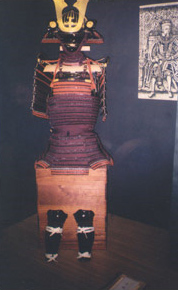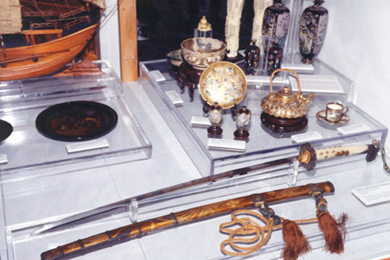|
A Gift From the East
|
Fujiyama Dojo P.O. Box 20003 Thorold, ON, Canada L2V 5B3 (905) 680-6389 |
|---|
 One would be hard pressed to find another place in the world that enjoys the fame and infamy, legend and history that the Tower of London has.
Of equal value to tourists, historians, ghost watchers, and anglophiles, the Tower remains a focal point for travelers, since no visit to the British Isles is quite complete unless one has visited the renowned structure and acquired at least one or two of its tales, so they can be retold at some appropriate time.
There is more than enough history between its walls to keep the mind occupied for quite a spell, but we would like to recommend to any traveler with an interest in Japanese History to visit the New Armories, a red brick building not far from the White Tower.
Once there, if we could divert the visitor's attention away from the formidable elephant armour and quite a few exhibits of weaponry, we'd like to point out a beautiful and well preserved Japanese medieval armour (yoroi), which sits seemingly out of place among so many Western relics.
The exhibit indicates that the armour was presented to James I by the governor of Edo, in 1613. But there is much more than that to its history. There is a connection, if we are permitted to lay our own version of "six degrees of separation", to the history of Daito ryu.
In 1612, the East Indian Company sent three ships to the Orient to trade in spices and other items. The expedition was commanded by a captain by the name of Saris who carried specific instructions to sail to Japan and attempt to negotiate a trading treaty if he was unable to fill all three ships in South East Asia ports.
The Portuguese and the Spaniards had been trading with Japan since the 1540's, and the Dutch began in the 1600's. England had fallen behind its competitors. Opening a trade relationship with Japan not only would be quite profitable, but it could also serve as a pathway to trade with China.
When Captain Saris arrived at Hirado1 he was met by a shipwrecked English seaman named Will Adams, advisor to the retired Shogun Tokugawa Ieyasu. William Adams, we are sure you realize, was the inspiration for Pilot Major John Blackthorne, the main character of James Clavell's popular novel Shogun. Saris explained his purpose to Adams and both men set off for Edo, but they made one very important stop on the way. The stopped at Sempu (currently Shizuoka) to meet with Ieyasu, who despite being officially retired, was still the real power in Japan. Very few things of political importance were done without his consent, and even fewer things happened of which he was not well informed.
With Ieyasu's approval they continued their journey to Edo where they met with the Shogun Tokougawa Hidetada, Ieyasu's son. One would be hard pressed to find another place in the world that enjoys the fame and infamy, legend and history that the Tower of London has.
Of equal value to tourists, historians, ghost watchers, and anglophiles, the Tower remains a focal point for travelers, since no visit to the British Isles is quite complete unless one has visited the renowned structure and acquired at least one or two of its tales, so they can be retold at some appropriate time.
There is more than enough history between its walls to keep the mind occupied for quite a spell, but we would like to recommend to any traveler with an interest in Japanese History to visit the New Armories, a red brick building not far from the White Tower.
Once there, if we could divert the visitor's attention away from the formidable elephant armour and quite a few exhibits of weaponry, we'd like to point out a beautiful and well preserved Japanese medieval armour (yoroi), which sits seemingly out of place among so many Western relics.
The exhibit indicates that the armour was presented to James I by the governor of Edo, in 1613. But there is much more than that to its history. There is a connection, if we are permitted to lay our own version of "six degrees of separation", to the history of Daito ryu.
In 1612, the East Indian Company sent three ships to the Orient to trade in spices and other items. The expedition was commanded by a captain by the name of Saris who carried specific instructions to sail to Japan and attempt to negotiate a trading treaty if he was unable to fill all three ships in South East Asia ports.
The Portuguese and the Spaniards had been trading with Japan since the 1540's, and the Dutch began in the 1600's. England had fallen behind its competitors. Opening a trade relationship with Japan not only would be quite profitable, but it could also serve as a pathway to trade with China.
When Captain Saris arrived at Hirado1 he was met by a shipwrecked English seaman named Will Adams, advisor to the retired Shogun Tokugawa Ieyasu. William Adams, we are sure you realize, was the inspiration for Pilot Major John Blackthorne, the main character of James Clavell's popular novel Shogun. Saris explained his purpose to Adams and both men set off for Edo, but they made one very important stop on the way. The stopped at Sempu (currently Shizuoka) to meet with Ieyasu, who despite being officially retired, was still the real power in Japan. Very few things of political importance were done without his consent, and even fewer things happened of which he was not well informed.
With Ieyasu's approval they continued their journey to Edo where they met with the Shogun Tokougawa Hidetada, Ieyasu's son.
 Hidetada received Captain Sairs on good terms. He entrusted him with a gift of two armours and a sword, plus decorated screens and other valuable items, to be given to King James I (VI of Scotland).
The two armours were of great quality, for they were made by Ieyasu's personal armourer, Iwai Yosaemon of Nara. The sword was a formidable cutting blade mounted in highly ornate ceremonial fittings.
Upon Captain Saris's return to England, the gifts were presented to the King. One armour was placed at the Tower of London, while the second one was kept at another location, probably a palace or a residence.
Following the execution of Charles I in 1649, the armour in the Tower was auctioned off, but it was recovered when Charles II came to the throne in 1660, and safely restored to its rightful place, where it has remained ever since.
The second armour, after being kept at various palaces, is now on loan from the Royal collection and it is displayed in the Royal Armouries Museum in Leeds.
How, you may ask, does this exhibit in the Tower of London connect to the history of Daito ryu? Then again, you may have already figured it out. The donator of the armour was Shogun Tokugawa Hidetada, the father of Hoshina Masayuki, Lord of Aizu.
Would knowing this make you a better budoka? It probably won't, but, if ever find yourself in Jolly Old England, we would still recommend you to visit the Tower of London and take a look at the old armour. It wouldn't hurt either. And we hear that the local fish and chips are outstanding. Hidetada received Captain Sairs on good terms. He entrusted him with a gift of two armours and a sword, plus decorated screens and other valuable items, to be given to King James I (VI of Scotland).
The two armours were of great quality, for they were made by Ieyasu's personal armourer, Iwai Yosaemon of Nara. The sword was a formidable cutting blade mounted in highly ornate ceremonial fittings.
Upon Captain Saris's return to England, the gifts were presented to the King. One armour was placed at the Tower of London, while the second one was kept at another location, probably a palace or a residence.
Following the execution of Charles I in 1649, the armour in the Tower was auctioned off, but it was recovered when Charles II came to the throne in 1660, and safely restored to its rightful place, where it has remained ever since.
The second armour, after being kept at various palaces, is now on loan from the Royal collection and it is displayed in the Royal Armouries Museum in Leeds.
How, you may ask, does this exhibit in the Tower of London connect to the history of Daito ryu? Then again, you may have already figured it out. The donator of the armour was Shogun Tokugawa Hidetada, the father of Hoshina Masayuki, Lord of Aizu.
Would knowing this make you a better budoka? It probably won't, but, if ever find yourself in Jolly Old England, we would still recommend you to visit the Tower of London and take a look at the old armour. It wouldn't hurt either. And we hear that the local fish and chips are outstanding.
1. Hiradoshima (Hirado Island) was the first port of entry of Western influence into Japan. In 1549 Francis Xavier arrived there aboard a Portuguese ship. William Adams was brought there as a castaway on a Dutch ship in 1600. Hirado became a relatively busy (and very dangerous at times) trading post for the Portuguese, Spanish, Dutch and English. It is also in Hirado where we find the tomb of William Adams, sitting high upon a hill, overlooking Hirado's port. James Clavell was not far off the mark when he called his book's main character Anjin-san. Adams was called Anjin Miura by most of his Japanese contemporaries. |
|---|


